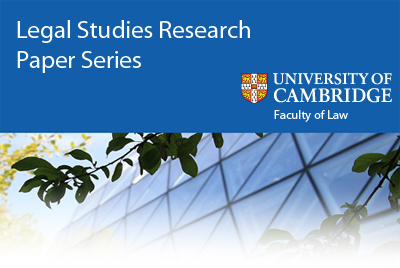 The Faculty has published Volume 7 Number 14 of the University of Cambridge Faculty of Law Legal Studies Research Paper Series on SSRN.
The Faculty has published Volume 7 Number 14 of the University of Cambridge Faculty of Law Legal Studies Research Paper Series on SSRN.
This issue includes the following articles:
Richard Hooley: Contractual Estoppel and the Misrepresentation Act 1967 (57/2016)
Contractual estoppel has been developed in the context of the exclusion of liability for misrepresentation. It provides a legal explanation for the validity of ‘no representation’ and ‘no reliance’ clauses, which may contradict the true state of affairs and prevent a claim for misrepresentation arising. The importance of contractual estoppel does not end there for it may be applied more generally to prevent parties denying the existence of a state of affairs which was the basis of their contract. This paper seeks to answer two central questions that continue to trouble the courts, most commonly when a claim is based upon the alleged mis-selling of a financial product. The questions are: (1) What is the true nature of contractual estoppel? (2) Are ‘no representation’ and ‘no reliance’ clauses subject to the test of reasonableness set out in the Unfair Contract Terms Act 1977, as extended to contractual terms which ‘exclude or restrict’ liability for misrepresentation by s 3 of the Misrepresentation Act 1967?
Kathleen Liddell et al: Pre-Mortem Interventions in Donation after Circulatory Death: A Proposal for Action (58/2016)
Contrary to the thrust of some government guidelines, pre-mortem interventions in organ donation after circulatory death (DCD) – even those involving some risks – can support (rather than conflict with) a potential donor’s legal “best interests” by ensuring that a donor’s organs have a better chance of saving other lives. It is important that UK law and guidelines which affect transplantation and transplantation research allow such conclusions to be reached when supported by the evidence for example a donor’s expressed wish to be an organ donor after death. It is also important that the law, guidelines and research ethics committees support further research studies. There are many ways in which pre-mortem interventions could be improved and new interventions are likely to emerge. Research will also generate data that enables better and more informed risk-benefit analyses to ensure a donor’s best interests have been considered as carefully as possible.
We recommend more specialised input into the UK research ethics committee approvals process, and caution against an overly narrow interpretation of section 31 of the Mental Capacity Act 2005(UK). The Court of Protection may also have a role to play. In situations where the pre-mortem intervention qualifies as “serious medical treatment”, the Court’s current Practice Directions recommend (or require) that doctors and researchers seek a declaration of lawfulness prior to carrying out a pre-mortem intervention. In time it is hoped that the particular pre-mortem interventions that fall within this category will become clearer and that the process of seeking a declaration will not be unfeasibly burdensome for the rapid time-frames of DCD donation. An issue for further research is the legality and ethics of pre-mortem interventions with DCD donors in other jurisdictions such as the US, Belgium and Australia.
Damien Charlotin & Wolfgang Alschner: The Growing Complexity of the International Court of Justice's Self-Citation Network: Institutional Achievement or Access-to-Justice Concern? (59/2016)
Using state-of-the-art information extraction, this article identifies 1865 references of the International Court of Justice (ICJ) to its own decisions or that of its predecessor between 1948 and 2013. We find that the ICJ self-citation network becomes increasingly complex. Citations are used more frequently and precedents grow more diverse. Two drivers fuel this development. First, jurisprudential specialization clusters citations in “classic” international law areas as the ICJ places increased emphasis on the continuity, expertise and predictability of its “settled jurisprudence” asserting its role among competing adjudicatory venues. Second, issue diversification expands citations as disputants increasingly craft their arguments around precedent making ICJ litigation more common-law like. The growth of citations adds complexity as precedent is predominantly used argumentatively to affect outcomes rather than ritualistically to pay tribute to past decisions. Although the growth of citations is an institutional achievement underscoring the Court’s continued relevance, it also creates new access-to-justice barriers.
Johnathon Liddicoat et al: The Examination Effect: A Comparison of the Outcome of Patent Examination in the US, Europe and Australia (60/2016)
The article provides an answer to a question that, rather surprisingly, has not been addressed in the academic literature to date: What is the practical effect of patent examination? It does so by undertaking an empirical analysis of the examination of nearly 500 patent applications, filed in identical form, in three patent offices – the United States Patent and Trademark Office (USPTO), the European Patent Office (EPO), and the Australian Patent Office (APO). We find that the routine effect of patent examination is to produce meaningful change to – and, in particular, a narrowing of – the definition of the invention contained in claim 1 of the patent. Importantly, this effect occurs significantly more often in the USPTO than in the EPO, and significantly more often in both of those offices than in the APO. Surprisingly, given the commonly-expressed view that the USPTO issues many “bad” patents, our findings suggest that the quality of patents granted by the USPTO may be higher than those granted by the other two offices.
Interested readers can browse the Working Paper Series at SSRN, or sign up to subscribe to distributions of the the e-journal.


 Facebook
Facebook  X/Twitter
X/Twitter  Instagram
Instagram  YouTube
YouTube  Flickr
Flickr  LinkedIn
LinkedIn